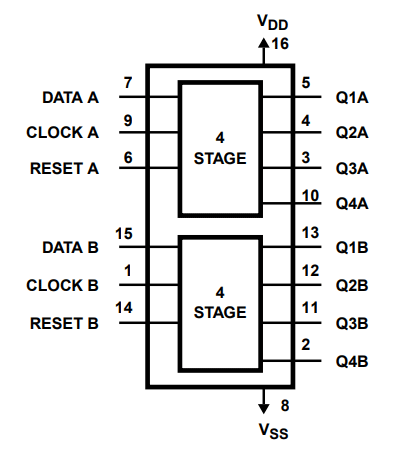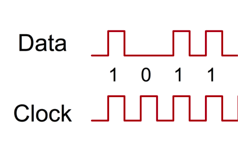CD4015 Dual 4-Stage Shift Register
The CD4015 is a Dual 4-bit Shift Register. It has a wide operating voltage upto 18V, hence can be used in high voltage applications. The IC is commonly used as I/O expander along with microcontroller to control multiple outputs like LED, LCD display etc..
Pin Configuration
|
Pin Number |
Pin Name |
Description |
|
1 |
Clock B |
Clock Pin - Pulse signal for Register B |
|
2, 3, 4, 5 |
Q1, Q2, Q3, Q4 - A |
4-bit Output pin for Register A |
|
6 |
RESET A |
Reset Pin for Register A |
|
7 |
DATA A |
Data Pin for Register A |
|
8 |
Vss (Ground) |
Connect to ground of the system |
|
9 |
CLOCK A |
Clock Pin - Pulse signal for Register A |
|
10, 11, 12, 13 |
Q1, Q2, Q3, Q4 – B |
4-bit Output pin for Register B |
|
14 |
RESET B |
Reset Pin for Register B |
|
15 |
DATA B |
Data Pin for Register B |
|
16 |
Vdd (Vcc) |
Supply Voltage – 5V, 10V, 15V |
Features
-
Dual 4-bit, Serial In – Parallel out Shift register
-
Operating Voltage: 3V to 18V
-
Power Consumption: 80uA
-
Clock Input Frequency: 8.5MHz @15V
-
Maximum Clock Frequency: 12Mhz @10V
- Available in 16-pin PDIP, GDIP, PDSO packages
Note: Complete Technical Details can be found at the CD4015 datasheet given at the end of this page.
Alternatives Shift Registers
|
S.No: |
Name |
Type |
|
1 |
4035 |
4-Bit Parallel in Parallel out Shift Register |
|
2 |
74LS379 |
Quad Parallel Shift Register |
|
3 |
4014 |
4 Bit static shift register |
|
4 |
74LS166 |
8 Bit Shift Register |
|
5 |
74LS323 |
8 Bit Shift/Storage Register |
|
6 |
74LS164 |
S/P Shift Register |
|
7 |
Dual 4 Bit Static Register |
|
|
8 |
74LS299 |
8 Bit Shift/Storage Register |
Where to use CD4015 IC
The CD4015 has two 4-bit Serial In – Parallel Out Shift Register. Meaning, it can receive (input) get data serially and control 4 output pins in parallel. This comes in very handy where do not have enough GPIO pins on our MCU/MPU to control the required number of outputs. It is often used in projects where relatively a large number of LED’s has to be controlled through the Microcontroller. It can also be used to interface LCD screen since they can acts as the data bit for the LCD displays.

Since the IC has two such Shift Registers in one package it can be used independently to control two outputs in parallel. Commonly used to drive two LCD in 4-bit Mode or control 7-Segment display. So if you are looking for a way to expand the I/O capability of your MCU then this IC might be the right choice for you.
How to use a CD4015 IC
Using the CD4015 IC is very similar to using the popular 74HC595 shift register. It requires only 3 pins connected to the MCU, which are Clock, Data and Reset. It has a wide operating voltage from 2V to 18V. An application circuit of the IC is shown below:

The CD4015 IC will have two Shift Registers (A and B) in a single package, for understanding purpose lets only consider the Register A as shown above. The pins 1, 15 and 4 are connected to the GPIO pins of the Microcontroller. In which pin 1 is the clock which sends a constant pulse to keep timing. The pin 15 is Data which actually sends the Data about which output pins has to stay low and which should go high. The Pin 14 is the Reset which updates the received the data to the output pins when made low, this pin can also be permanently held low. The below image will help you understand better

As you can see the clock is continues train of pulses, and the data goes high only at the respective place where the output has to get high. Here for example the binary value 0b1011 is passed to the microcontroller. The pin Master reset (MR) is used to reset the outputs, when not in use it is held high to vcc, similarly the pin should be held low when not in use.
Applications
- Expand the GPIO pin on a MCU/MPU
- LED Matrix/Cube Projects
- Interface LCD
- Cascading applications
- High logic level controller
2D Model of CD4026 (PDIP)











